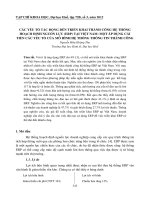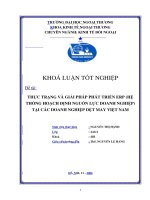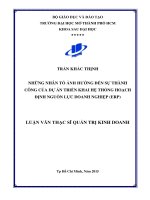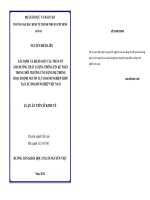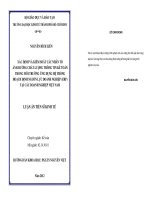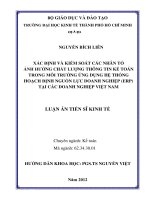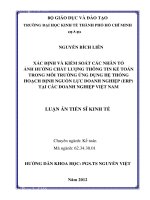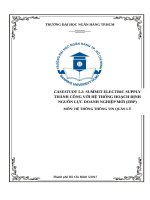PHÁT TRIỂN mô HÌNH sử DỤNG THÀNH CÔNG hệ THỐNG HOẠCH ĐỊNH NGUỒN lực DOANH NGHIỆP CHO các CHUYÊN GIA kế TOÁN tt tiếng anh
Bạn đang xem bản rút gọn của tài liệu. Xem và tải ngay bản đầy đủ của tài liệu tại đây (1.12 MB, 29 trang )
MINISTRY OF EDUCATION AND TRAINING
UNIVERSITY OF ECONOMICS HO CHI MINH CITY
-----
Phan Thi Bao Quyen
A DEVELOPMENT OF
ENTERPRISE RESOURCE PLANNING SUCCESS
MODEL FOR ACCOUNTING PROFESSIONALS
Major: Accounting
Code: 9340301
A DOCTORAL THESIS SUMMARY
Ho Chi Minh City, 2020
A doctoral dissertation is submitted for the Degree of Doctor of Philosophy in
Accounting at the University of Economics Ho Chi Minh City.
Supervisors:
Associate Professor, Dr. Vo, Van Nhi
Dr. Nguyen, Thi Kim Cuc
Reviewer 1: ..............................................................................................
Reviewer 2: ..............................................................................................
Reviewer 3: ..............................................................................................
This thesis is accepted by the School of Accounting and School of UEH
Graduate in partially fulfillment of the requirements for the degree of Doctor
of Philosophy in Accounting:
Date
Dean of the School of Accounting
Date
Dean of the School of UEH Graduate
ABSTRACT
Enterprise Resource Planning (ERP) system is commercial software that
automates and integrates many or most of a firm’s business processes. It
allows to access to integrated data cross the entire enterprise according to realtime (Davenport, 1998). Therefore, ERP system is expected to increase
productivity via processes standardization, to improve decision-making ability
via information integration throughout the whole enterprise, to enhance
cooperation between organizational entities by connecting them smoothly, and
the most important, to maintain competitive advantage once these benefits are
satisfied (Davenport, 1998). These promises are possibly a close explanation of
its increasing popularity. Namely, Fortune 500 companies are trusting ERP
system 1 and it is also a solution that large-sized organizations in Vietnam
select and adopt more growingly2.
Nevertheless, instead of achieving impressive benefits from their ERP systems,
some firms have faced difficulties in gaining the benefits they expected.
Therefore, as suggested by Markus and Tanis (2000), for both researcher and
executives, one of the initial interested-questions is whether investments in
ERP will pay off. Several organizational-level econometric studies conducted
(M. C. Anderson, Banker, & Ravindran, 2003; Hitt, Wu, & Zhou, 2002) give
an answer that it is likely yes – on average. However, the impacts vary from
enterprise to enterprise, even from module to module (Nicolaou, 2004a) in
which accounting-related modules are in charge of changed-focuses. Kanellou
and Spathis (2013) perform the relevant literature and conclude that ERP
implementation has a considerable impact on accounting department of the
business organizations. Hence, the executives’ next questions are probably to
be, how can I maximize the positive impacts on accounting department? Is
there some way to predict what the ultimate impacts of ERP systems on
accounting professionals will be in order to achieve a goal of enhancing
organizational performance?
1
This information is quoted from website />2
This information is quoted from Vietnamese E-commerce Indicator Report in 2018.
These questions are worth addressing. In attempting to do so, the author draws
on D&M IS success model (DeLone & McLean, 1992), IS-continuance theory
(Bhattacherjee, 2001) and the principle “fitness for use” (J. M. Juran, 1988) to
develop the ERP success model for accounting professionals in order to make
them more productive, which in turn improves performance of implemented
organizations. The theoretical and empirical results indicate that organizational
performance is, indeed, influenced by the extent to which accounting experts
effectively utilize ERP systems in the adoption and ongoing context.
This study makes an original contribution to both of theory and practice
through forming and validating the ERP success model for accounting
professionals only. In a little more detail, it provides empirical evidence
regarding Hunton’s accounting value chain (2002). In addition, it discovers
and proves effective use as the most appropriate system-use concept so far.
Moreover, it makes an effort to investigate outcomes of accounting benefits
perceived from ERP system, which related-studies are much further underresearched. Last but not least, the research provides valuable implications for
organization management on how they can successfully manage accounting
department as well as accounting professionals in an attempt to maximize
ERP’s impacts on organizational performance, which executives have paid
much attention to for recent years but have not yet found out the answer so far.
Key words: ERP success model, accounting professionals, perceived
accounting benefits, system use, the principle "fitness for use"
1
CHAPTER 1
INTRODUCTION
1.1 Chapter introduction
The purposes of this chapter are to describe a broad overview of the research.
1.2 Background of research
This study is conducted in the context, which the ERP system has already been
one of the most popular business-management-applications in organizations all
over the world and begins to be increasingly adopted in Vietnam.
1.3 Motivations for research
1.3.1 Motivation 1 - ERP research
Huang and Yasuda (2016) summarize that a field of critical success factors is
one of the most mentioned ERP-related topics. The CSF researches have
typically addressed several different issues. In most cases, typical CSF studies
have consistently identified a set of core factors critical to the success of ERP
implementations. However, the few researchers are interested in building ERP
success models as untypical CSF studies. Finney and Corbett (2007) lament the
fact that most of recent ERP CSF research (both typical and untypical CSF
type) has generally taken from a macro perspective or a view of multiple top
mangers, the perspectives of key or single stakeholders are often missing. For
these reasons, a call for developing a model measuring ERP success from
stakeholders’ perspective has been established for recent years.
1.3.2 Motivation 2 – Behavioral Accounting Research (BAR)
Behavioral accounting research (BAR) is defined as the study of accounting
professionals’ behavior or non-accountants’ behavior influenced by accounting
functions, and/or report system, and/or creating accounting information
(Hofstedt & Kinard, 1970). This thesis focuses on “study of accountants” due to
its increasing concern in BAR literature; the more growingly intertwined
relationship between accountants and ERP system; and their valuable
contributions in IS-adopting business organizations.
1.3.3 Combination of ERP research and BAR
Because of its accounting benefits, ERP requires accounting expertises to change
their role in order to make broader contribution to the company, such as
2
reporting
on
non-financial
measures,
auditing
information
systems,
implementing management controls within information systems, and providing
management consulting services (Grabski, Leech, & Schmidt, 2011). Therefore,
the thesis will combine ERP CSFs research with the study of accountants to
formulate a research topic. That is to discover how to assess ERP success for
accounting professionals from accounting professionals’ perspective themselves,
or, developing an ERP success model for accounting professionals (ESMAP).
1.4 Research objective
The primary objective of this research is to develop and test ERP success model
for accounting professionals at organizational level.
1.5 Research questions
The managerial question of this thesis is that “How can the ESMAP be designed
in an attempt to improve accountant performance, which in turn enhances
organizational performance?” Two research questions extracted from the
managerial question are sequent that: “How can the ESMAP be formed in an
attempt to improve accountant performance, which in turn enhances
organizational performance?” and “ How can the ESMAP be validated?”
1.6 Justification
From a theoretical perspective, this study is significant and worth. First, the
ESMAP more provides empirical evidence on the accounting value chain of
Hunton (2002). Second, it should be noted that almost previous studies pay
attention on perspectives of multiple stakeholders on ERP success while this
study focuses on perceptions of accounting professionals only. Third, perceived
accounting benefit concept is firstly validated in the complex model as the
ESMAP. Finally, the ESMAP focusing on the post-implementation stage adds
more insights into the paucity of research on ERP system after implementation
(Grabski et al., 2011).
This study is also an essential from a practical standpoint. The ESMAP is
precious as it guides accounting professionals how to become productive under
ERP settings. Furthermore, the ESMAP guides organization management how
to predict, access and improve organization’s accountant performance to
achieve the advanced organizational performance for their organizations.
3
Finally, organization will obtain beneficial outcome when individual benefits
are positive influenced.
1.7 Methodology
This study makes use of positivism paradigm and quantitative research method.
It is divided into two phases: forming the ESMAP, and validating the ESMAP.
To start with, it reviews related literature and finds suitable foundational
theories to propose the ESMAP with its 9 hypotheses and its constructsconceptualization. Then, the empirical survey data is obtained from an expected
sample of 300 organizations in Vietnam adopting the ERP system for at least
one year. The ESMAP’s constructs operationalization and their validation are
subsequently conducted via SPSS 24.0 and AMOS 20.0. Finally, the theoretical
model and hypotheses of the ESMAP are tested using PLS-SEM analysis
technique with the support of Smart PLS 3.2.7.
1.8 Research scope
This study is conducted in Vietnam. The ‘ERP success’ term in the current
study is referred to how to adopt ERP system to improve effectiveness in
implemented enterprises. The study unlimited considers various ERP packages
including foreign and local brands because varying in system’s types, to some
extent, may increase software-related generalizability of this study. The thesis’s
unit of analysis is at organizational level.
1.9 Thesis structure
Figure 1.1: A systematic procedure for designing the ESMAP
1.10 Chapter summary
------------------------------
4
CHAPTER 2
LITERATURE REVIEW
2.1 Chapter introduction
Chapter 2 introduces the basic literature of Enterprise Resource Planning, a
review of the existing ERP Success Models, and a review of ‘rich construct(s)’.
2.2.1 Defining ERP
Based on different ERP-related definitions of Davenport (2000), Soh, Kien, and
Tay-Yap (2000), Nah, Lau, & Kuang (2001), and Loh & Koh (2004), it could be
conducted that an ERP is a packaged complex business software designed to
integrate business processes and functions through using single database in order
to be able to permit the sharing of common data and information in real time.
2.2.2 Evolution of ERP
2.2.3 Advantages and disadvantages of ERP
ERP system's advantages include reliable accessibility, avoiding duplication of
data, transportation and reduction of turnaround time, minimizing cost,
flexibility, more capability of expansion, enhanced and active long-term
maintenance, association with parties on a global scale, and increasing ecommerce, e-business (Mohammad A. Rashid et al., 2002).
ERP system's disadvantages consist of spending a lot of time to implement a
system, costly price,
matching between ERP and organization’ business
processes, dependence on ERP vendor, multi-features system and its
complexity nature, global scalability, and capability of ERP extension
(Mohammad A. Rashid et al., 2002).
2.2.4 The ERP lifecycle
This research chooses Change et al.’s (2000) approach to divide the ERP
lifecycle into three principal phases: pre-implementation, implementation and
post-implementation.
5
2.3 ERP Success Models
2.3.1 Challenges of measuring ERP success
In the context of this thesis, except for efforts to reflect complex nature of the
ERP system, evaluating intangible success of ERP system is focused rather than
its tangible benefits.
2.3.2 A summary of ERP Success Models from 1990 up to present
Although a history of ERP evolution has lasted almost three decades, the
quantity of these ERP success studies up to present is eleven, actually not
much. The common points of most of such models are to utilize system quality,
information quality, and user satisfaction as measure of ERP success. Based on
this analysis, it could be said that the D&M IS Success model (1992) is
considered as underlying theory of most of existing ERP success models. The
study are also going to adopt it as our underlying theoretical framework when
developing the ESMAP.
2.3.3 Issues with the existing ERP success studies
Issues with the existing ERP success studies are a lack of research in ERP
ongoing system success evaluation, considering appropriateness of additional
construct(s) which is embedded into the chosen ESM, essentialness of system
use construct in the ESM, the completeness of D&M IS success model’s
success dimensions, the match between construct measurements and
characteristics of contemporary ERP system, the call for understanding
perspective of a particular stakeholder (i.e., accounting professionals), the call
for combining the D&M IS success model with appropriate underlying theories,
and recommendations of empirical testing the ERP success model.
2.3.4 Differences between the current study and the previous ESMs
This research is valuable and worth as it covers all the existing issues in the
previous ESMs.
2.3.5 Review of ERP success studies in Vietnam
The current study is to develop an ERP success model for accounting
professionals in order to guide them how to become increasingly productive
enabling enhanced organizational performance when adopting ERP. For this, it
is obvious that the research idea is entirely different from all four previous
6
ERP-related studies in Vietnam (Hiền & Trung, 2014; Thanh, 2015; Thọ, 2013;
Thông, 2017). It can be stated that the current research topic is not a duplicate
of any ERP-related studies in Vietnam, and thus, it is unique in Vietnam.
2.4 Review of ‘rich construct(s)’ enabling to overcome unanswered
validity-setting-related issues
Through an extensive review, a construct of accounting benefits perceived from
ERP system is under discussion. The author selects conceptualization and
operationalization of Kanellou and Spathis (2013)’s scale as it is validated by
testing the relationship between it and user satisfaction.
2.5 Chapter summary
-----------------------------CHAPTER 3
CONCEPTUAL FRAMEWORK,
CONSTRUCT CONCEPTUALIZATION AND HYPOTHESES
3.1 Chapter introduction
This chapter covers two last steps of phase one of the process on how to design
the ESMAP, which is presented in Chapter 1.
3.2 Theories used in the ESMAP
3.2.1 D&M IS success model (DeLone & McLean, 1992)
This study chooses the D&M IS success model (1992) as an underlying model
of the ESMAP.
3.2.2 IS-continuance theory (Bhattacherjee, 2001)
The IS-continuance theory is chosen to clarify the links between system quality,
information quality, perceived accounting benefit and satisfaction.
3.2.3 Principle “fitness for use” (Juran, 1988)
According to the principle “fitness for use”, the author assumes that the ESMAP
aims to guarantee ERP system quality in order to enable to maximize ERP’s
“economic benefits”. For this assumption, accounting professionals (“who”),
based on system quality, information quality, perceived accounting benefit
(“what” available), exploit effectively ERP system (“how” element, which refers
to its use and satisfaction – users’ feeling when using ERP system) to achieve
“economic benefits”, including improved accountant performance (ERP’s
7
impacts on accounting experts) and enhanced organizational performance,
(ERP’s impact on organizations) that accountants expect when using the ERP
system. Therefore, system quality, information quality and perceived accounting
benefit are antecedents of use and satisfaction while accountant performance and
organizational performance are their outcomes.
3.2.4 How to combine three theories to form the ESMAP
Based on the D&M IS Success model, IS- continuance theory is adopted and
adapted to clarify path relationships between system quality, information
quality and perceived accounting benefit in sequence and use as well as and
satisfaction. After all, the principle “fitness for use” is utilized to connect the
appearance of all constructs in the ESMAP.
3.3 Conceptual ESMAP, construct conceptualization and hypotheses
3.3.1 Conceptual ESMAP
Figure 3.1: The research model (the ESMAP)
3.3.2 Relationships among constructs of organizational-level impacts
3.3.2.1 Organizational performance
Organizational impact is described as “the benefits that the organizations gets
from its ERP system, often measured by the extent to which customer service,
decision-making process, and so forth have been enhanced” (Ifinedo, Rapp,
Ifinedo, & Sundberg, 2010, p. 1140).
3.3.2.2 Accountant performance
According to Hsu, Yen, and Chung (2015), this study considers accountant
performance as accounting professionals’ perceptions of the importance and
usefulness of the ERP system that affect their capabilities and effectiveness.
H1. Accountant performance has a positive influence on organizational performance.
8
3.3.2.3 Use
According to Deng, Doll, and Truong (2004), use in this study is referred to
how effectively an ERP system is used for the fundamental organizational
functions such as problem-solving/ decision-making, work integration, and
work planning.
H2. Use (effective ERP use) has positive influence on accountant performance.
3.3.2.4 Satisfaction
According to Hsu et al. (2015), satisfaction in this context is referred to “the
extent to which accounting professionals perceive a match between their
requirements and ERP functionality.”
H3. Satisfaction has positive influence on accountant performance.
3.3.3 Perceived qualities and benefits; and organizational-level impacts
3.3.3.1 System quality
Hsu et al. (2015) refer system quality as performance characteristics of the ERP
system in relation to system-related quality and task-related quality.
Accordingly, the author selects system-quality-definition of Hsu et al. (2015)
for the current study.
H4a. System quality has positive influence on use.
H4b. System quality has positive influence on satisfaction.
3.3.3.2 Information quality
Hsu et al. (2015) refer information quality as characteristics of the output
provided by the ERP system with regard to contextual quality and
representative quality. Accordingly, the author selects information-qualitydefinition of Hsu et al. (2015) for the current study.
H5a. Information quality has positive influence on use.
H5b. Information quality has positive influence on satisfaction.
3.3.3.3. Perceived accounting benefit
According to Kanellou and Spathis (2013), perceived accounting benefit in this
study is defined as accounting-related performance characteristics of the ERP
system in relation to five accounting-related aspects such as IT accounting benefits,
operational accounting benefits (time), organizational accounting benefits,
managerial accounting benefits, and operational accounting benefits (cost).
9
H6a. Perceived accounting benefit has positive influence on use.
H6b. Perceived accounting benefit has positive influence on satisfaction.
3.4 Chapter summary
-----------------------------CHAPTER 4
RESEARCH METHODOLOGY
4.1 Chapter introduction
This chapter is to explain and justify the research methodology used to address
the second research question “how is the ERP success model for accounting
professional tested?”.
4.2 Research approach
4.2.1 The nature of the phenomenon being studied
This study matches deductive approach and empirical research.
4.2.2 Research approach selection
The quantitative method is primarily adopted to answer the main research
question “How can ESMAP be designed to improve accountant performance,
which in turn enhances organizational performance?”
4.3 Philosophical worldview
Creswell (2009) proposes that positivism is the research paradigm appropriate
for developing and testing the study’s model against empirical data.
4.4 Research design
4.4.1 Selecting the type of research method
Survey method with questionnaire technique is adopted in this study.
4.4.2 Time horizons
This is longitudinal study as it represents events over a given period (Saunders,
Lewis, & Thornhill, 2003).
4.5 Research method
The section is to explain how survey research process is conducted in this study
in the step-by-step manner, namely:
Instrument design (Section 4.5.1)
Sample design (Section 4.5.2)
Data collection (Section 4.5.3)
10
Data preparation (see Section 5.2)
Assess reliability and validity of each construct separately (Section 5.3)
Assess measurement model of the all constructs in the ESMAP
(Section 5.4)
Assess structural model of the ESMAP (Section 5.4)
Discussion on the research findings of the ESMAP (Chapter 6)
Interpretation of the ESMAP’s contributions, theory and practice
(Section 7.3)
4.5.1 Instrument design
4.5.1.1 Measure choices of constructs
Table 4.1: Conceptualization and operationalization of the constructs
Construct
Definition/ Description
Measure
System Quality
Performance characteristics of the ERP system in relation to
system-related quality and task-related quality (Hsu et al. (2015)
System Quality is measured with 8
items according to Hsu et al. (2015)
Information
Quality
Characteristics of the output provided by the ERP system with
regard to contextual quality and representative quality (Hsu et al.
(2015)
Information quality is measured by
using a 5-item scale adapted from
Hsu et al. (2015)
Perceived
Accounting
Benefit
Accounting-related performance characteristics of the ERP system
in relation to five accounting-related aspects such as IT accounting
benefits, operational accounting benefits (time), organizational
accounting benefits, managerial accounting benefits, operational
accounting benefits (cost) (Kanellou & Spathis, 2013)
Perceived-accounting-benefit
instrument developed by Kanellou
and Spathis (2013) includes 5
dimensions and 18 items.
Use
In organization, an ERP system is used to perform important
organizational functions such as problem-solving/ decisionmaking, work integration, and work planning. Use refers to how
effectively an ERP system is used for theses organizational
functions. (Adapted from Deng et al. (2004))
This study employs Deng et al.
(2004)'s eleven items aggregated
into four congeneric indicators.
Satisfaction
The extent to which accounting professionals perceive a match
between their requirement and ERP functionality (Hsu et al.
(2015)
User satisfaction measure of Hsu et
al. (2015) with a 4-item scale is
selected.
Accountant
Performance
Accounting professionals’ perceptions of the importance and
usefulness of the ERP system that affect their capabilities and
effectiveness (Hsu et al. (2015)
A 4-item scale of Hsu et al. (2015)
and Gable et al. (2008) is adopted to
measure accountant performance.
Organizational
Performance
The benefits that the organization gets from its ERP system, often
measured by the extent to which customer service, decisionmaking processes, and so forth have been enhanced (Ifinedo et al.
(2010)
Items used for organizational
performance are obtained from
Ifinedo et al. (2010).
4.5.1.2 Identifying formative and reflective constructs.
According to Jarvis et al.’s (2003), System quality and information quality are
modeled as second-order formative – reflective constructs. Perceived
Accounting Benefit is a second-order reflective-reflective construct. Use is
11
conceptualized as a reflective-reflective construct. Satisfaction, Accountant
performance and Organizational Performance are modeled as reflective
constructs in this study.
4.5.1.3 Ensuring content validity for constructs
Based on these measurement scales, the items of the questionnaire are
proposed. This study will apply expert panel to improve the reliability of the
instrument. Based on their feedbacks, two adjustments are done. The translation
of the questionnaire into Vietnamese is conducted through Brislin’s translation
process to assure consistency in meaning. The pilot testing can be conducted to
revise the questionnaire at the last time. Before collecting data, this study
considers several bias issues such as response and non-response bias and
common method bias and mentions some solutions controlled and carried out in
relation to designing questions and how to collect data in order to minimize
these bias issues.
4.5.2 Sample design
This research is conducted in Vietnam. The sample organizations are firms
adopting ERP system in Vietnam for at least one year. The respondents in this
study are defined as CFOs, chief accountants, internal controller, internal
auditors, and management accountants who take part in organizations
implemented ERP system for at least one year and have at least two-year
working experience at the current position. Based on minimize sample size of
each statistical method, the minimize sample size of the current study decided
is 90. Sample is collected by snowball sampling technique.
4.5.3 Data collection
Email with the survey link is sent to all potential informants’ 5110 email
addresses. After six rounds of data collection, just 136/549 responses are valid.
4.6 Ethical considerations
Nowadays, research ethics are an issue that needs to be paid more attention to,
especially when researchers conduct any studies on organization.
4.7 Chapter summary
------------------------------
12
CHAPTER 5
DATA ANALYSIS
5.1 Chapter introduction
This chapter is systematically divided into three steps including data
preparation, instrument preparation, and testing the ESMAP.
5.2 Step 1: Data preparation
5.2.1 Data screening and cleaning
After screening and cleaning, 433 cases of 569 responses received not matching
identified criteria are deleted. The left 136 responses are usable for further analysis.
5.2.2 Straight lining check
Straight lining happens when the respondent selects the same response for the
entire set of items on a screen. Accordingly, the author discovers that there are
no cases with straight lining.
5.2.3 Testing for outliers
This study utilizes Stem and Leaf analysis on SPSS with multivariate method to
identify outliers. Accordingly, this study needs to delete 16 outliers.
5.2.4 Bias Tests
In order to be likely possible to generalize the research findings from the
sample to the population; non-response bias and common method bias test are
conducted.
5.2.5 Section summary
5.3 Step 2: Instrument preparation
5.3.1 Instrument reliability assessment
Internal consistency is adopted to assess reliability through two statistical
indicators: item-total correlation and Cronbach’s alpha. All the item-total
correlation value of each item to its designated instrument is greater than the
cut-off value of 0.3. In meantime, the Cronbach’s alpha values of the
instruments are almost greater 0.9. Therefore, reliability of each instrument is
extremely excellent.
5.3.2 Instrument validity assessment
To consider instrument structure, and to define a small number of factors that
adequately represent the original set of variables, this study utilizes data-
13
summarization-related exploratory factor analysis.
5.3.2.1 Assumption consideration
The current study considers sample characteristics and concludes that the data set
has normal distribution, its homoscedasticity is certain, and its linearity is valid.
5.3.2.2 Sample size consideration
The minimize simple size in this study as discussed in Section 4.5.2.3 is 90.
The existing sample size in this study is 120, then, satisfied.
5.3.2.3 Appropriateness assessment
The results of Bartlett’s test and the Kaiser-Meyer-Olkin test show that a factor
analysis may be useful with the data.
5.3.2.4 Interpreting the factors
The EFA results show that, of the 9 scales, information quality, satisfaction,
accountant performance, organizational performance, extent of use and intend
to use are immediately acceptable and three need to refine.
5.3.2.5 Factor explanation
Table 5.1: New conceptualization and operationalization of new factors extracted from EFA
Instrument
Factor
Item
Definition
System
System-related
SQ1, SQ2, SQ7
Performance characteristics of the ERP system with
quality
quality
regard to using system
Task-related
SQ5, SQ6, SQ8
Performance characteristics of the ERP system with
quality
regard to specific tasks and settings
Information Information
IQ1, IQ2, IQ3, IQ4, IQ5,
Characteristics of the output provided by the ERP
quality
quality
IQ6
system with respect to timeliness, relevance,
availability, and understandability, and so forth
Perceived
Operational
PAB6, PAB7, PAB8,
The benefits that the users get from ERP system
accounting
accounting
PAB9, PAB10
with respect to reduction of time for closure, and
benefit
benefit
issuing financial statements
Organizational
PAB11, PAB12, PAB13,
The benefits that the users get from ERP system
accounting
PAB14, PAB15, PAB16,
with respect to organizational flexibility and
benefit
PAB17, PAB18
effectiveness
Use
Decision
USE1, USE3, USE4,
The extent that ERP system is used to improve the
support
USE7
decision making processes
Work
USE5, USE6, USE8,
The extent that ERP system is used to coordinate
integration
USE11
work activities with others in one’s work group and
manage one’s own work
5.3.2.6 Fit consideration of higher-order factor instrument model
The author subsequently conduct confirmation analysis through AMOS-SEM
with the target of re-confirming whether the second-order construct is the most
14
appropriate model measuring concepts that they capture. The results of
confirmation analysis indicate that perceived accounting benefit and use
concepts fit best with second-order constructs.
5.3.2.7 Section summary
5.4 Step 3: Testing the ESMAP
5.4.1 Analysis technique selection
PLS-SEM multivariate analysis technique is chosen to test the EMSAP.
5.4.2 Measurement model assessment
The results indicate that all reflective first-order constructs achieve the
reliability, convergent validity and discriminant validity and all reflective
second-order constructs satisfy the reliability and convergent validity. Besides,
the result shows that system quality is suitable to formative second-factor
measurement model.
5.4.3 Structural model assessment
5.4.3.1 Structural model assessment
H:
H1:
Relationship
AP -> OP
Table 5.2: Direct relationships for hypothesis testing
Std
Std
[t Decision
Beta
Error
value]^
f2
0.638
0.065
9.658***
Supported
H2:
USE -> AP
0.253
0.073
3.453***
Supported
H3:
SAT -> AP
0.535
0.071
7.598***
H4a:
SQ -> USE
0.01
0.12
0.107
H4b:
SQ -> SAT
0.28
0.085
H5a:
IQ -> USE
0.054
0.115
H5b:
IQ -> SAT
0.128
H6a:
PAB -> USE
H6b:
PAB -> SAT
q2
95%
CI LL
0.523
95%
CI UL
0.735
0.084
0.049
0.133
0.373
Supported
0.385
0.221
0.415
0.647
No
0
0
-0.191
0.206
3.322***
Supported
0.083
0.053
0.142
0.418
0.425
No
0.002
0
-0.131
0.242
0.104
1.218
No
0.014
0.006
-0.05
0.295
0.622
0.11
5.695***
Supported
0.313
0.124
0.436
0.794
0.473
0.102
4.624***
Supported
0.271
0.171
0.309
0.646
*** p<0.001
R2 (Use = 0.447; Satisfaction = 0.639; Accounting Performance = 0.509; Organizational Performance = 0.399)
Effect Size impact indicator are according to Cohen (1988), f2 values: 0.35 (strong effect), 0.15 (moderate effect), 0.02 (weak effect)
Q2 (Use = 0.243; Satisfaction = 0.527; Accounting Performance = 0.376; Organizational Performance = 0.235)
Predictive Relevance (q2) of Predictor Exogenous Latent Variable as according to Henseler, Ringle, and Sinkovics (2009)
5.4.3.2 PLS-SEM mediator analysis
To test mediating effects, Nitzl (2016), Carrión, Nitzl, and Roldán (2017)
specifically describe a procedure for mediation analysis by using PLS-SEM.
They suggest adopting Consistent PLS Bootstrapping, which especially works
15
for multiple mediator models. The result indicates that the ESMAP exists one
full and three partial mediating relationships.
5.4.3.3 PLS multiple-group analysis (PLS-MGA)
This study organizes multi-group analyses, in which groups are divided by the
length of ERP duration, by organizational size, and by ERP vendor
respectively. The results of PLS-MGA determine these differences as expected.
5.4.3.4 Alternative models analysis
To further understand how effective use construct may increase explanatory
power in the ESMAP as well as assessing whether effective use is really an
appropriate ongoing use in ERP environment, the author sequentially test the
ESMAP with frequent use, called Extent of Use (Ex_U), and with intend to
continuously use, labeled Extended Use (Extended_U). The results confirm that
effective use is a rich and meaningful measure of system use for an
implemented ERP system.
5.4.3.5 Parsimonious model analysis
The author considers eliminating information quality from the ESMAP, and
then, the parsimonious model without information quality is proposed. After
parsimonious model analysis, comment on eliminating information system
from the ESMAP is absolutely reasonable.
5.4.3.6 Section Summary
5.5 Chapter summary
-----------------------------CHAPTER 6
DISCUSSION OF FINDINGS
6.1 Chapter introduction
This chapter provides detail discussions of findings presented in Chapter 5.
6.2 Descriptive findings
120 organizations come from a wide spectrum of industry types, from different
types of industry sectors, and from different size. These enterprises utilize
different ERP packages implemented from at least 1 years. The informants have
bachelor university degrees, 52.5% of them are female. Most of them are aged
between 25 and 34 years old. They have 6.5 years work experience on average,
16
including approximately 2.7 years using ERP system at current position. And it
is noted that they utilize ERP system frequently (5.4 of 7-likert scales).
6.3 An overview of the relationship between accountant performance and
organizational performance
6.3.1 Discussion on organizations’ perceptions of organizational performance
Most of all recognize that the ERP systems remarkably facilitate enhancing
fundamental business benefits except for customer-service-related benefit in
which the number of organizations agreeing on this benefit is equal to those that
give rejections.
6.3.2 Discussion on organizations’ perceptions of accountant performance
The approximately 23% of the participants in this study realize certainly
positive impacts of their ERP systems on their job performance are absolutely
ERP-experienced managers.
6.3.3 Discussion on direct impact of accountant performance on
organizational performance
H1 is supported, which indicates that when accounting professionals become
productive under the ERP context, their organizational performance will be
considerably enhanced.
6.4 Use and its outcomes
6.4.1 Discussion on organizations’ perceptions of use
On average, the massive majority of organizations indicate that use facilitates and
even significantly facilitates developing high-level accounting experts’ ability.
6.4.2 Discussion on appropriateness of effective use in the ERP context
Alternative models analysis is used o evaluate whether or not effective ERP use
is an appropriate measure in post-implementation context. The statistical
evidence supporting the author’s argument that “effective use” is a rich, and
meaningful measures of system use for a post-implementation ERP system.
6.4.3 Discussion on direct impact of effective use on accountant performance
H2 is supported. This convinces inexperience and unconfident accounting
professionals that the more extensively the ERP system is used for decision
support and work integration, the more likely these experts will perceive that
ERP system has considerably positive impacts on their work.
17
6.4.4 Additional discussion on indirect impact of effective use on
organizational performance
Given PLS-SEM mediator analysis, it can be said that closely 100% of the total
effect between use and organizational performance is due to an accountantperformance-mediator.
6.5 Satisfaction and its outcomes
6.5.1 Discussion on organizations’ perceptions of satisfaction
The number of respondent organizations are satisfied with the overall ERP
system is extremely expressive with greater than 91% of total.
6.5.2 Discussion on direct impact of satisfaction on accountant performance
H3 is supported. That means the more satisfied accounting professionals are
with ERP system, the more strongly they agree that the ERP system supports
them to perform well their routine work.
6.5.3 Additional discussion on direct and indirect impact of satisfaction on
organizational performance
The author has sufficient proof to believe that either the more satisfied the
accounting professionals feel about how the ERP system runs, the more
significant firm’s operation effectiveness improves or the more satisfied the
accounting professionals feel about how the ERP system runs, the more excited
and motivated they work, the better and even more excellent their tasks
accomplished, and then the more effectively business organizations operate.
6.6 System quality and its direct impacts on use and satisfaction
6.6.1 Discussion on organizations’ perceptions of system quality
Overall, most of organizations ranging from 80.22% to 100% agree that system
quality is significant acceptable, except the quality of flexibility (just
approximately 66%)
6.6.2 Discussion on direct impact of system quality on use
H4a is not supported. Possibly, because of being forced to use ineffective ERP
system, after being trained, familiar with and even experienced in a new
system, accounting professionals perhaps change how to use the ERP system.
Specifically, they can either choose to use an alternative system or increasingly
use manual functions to satisfy their needs temporarily.
18
6.6.3 Discussion on direct impact of system quality on satisfaction
The results strongly support the hypothesis H4b. It means that the better the
system quality is, the more satisfied users feel when using it.
6.7 Information quality and its direct impacts on use and satisfaction
6.7.1 Discussion on organizations’ perceptions of information quality
Generally, almost surveyed organizations (86% on average) have the same
perception that information system facilitates that the ERP system provides
exactly what they need, information from the ERP is always available, in a
form readily usable, readable, clear, well-formatted and concise.
6.7.2 Discussion on direct impact of information quality on use
H5a is not supported. This finding is a more knowledgeable contribution of the
current study to provide more insights into ongoing ERP-related literature.
6.7.3 Discussion on direct impact of information quality on satisfaction
H5b is not supported. This finding is inconsistent with a numerous previous
related-studies at individual level (Hsu et al., 2015) and fewer studies at
organizational level (Scheepers, Scheepers, & Ngwenyama, 2006). However,
Petter, DeLone, and McLean (2008) also agree that it is difficult to draw any
conclusion when analysis unit is firm. Therefore, this result is acceptable.
6.7.4 Discussion on the role of information quality in D&M IS success model
To more clarify why information quality does not have significantly direct
influences on both use and satisfaction, validating the original D&M IS success
model (1992) without appearance of perceived accounting benefit is conducted.
The result indicates that without perceived accounting benefit, information
quality still affects use and satisfaction at significant level. Therefore, since its
appearance, perceived accounting benefit has attracted the attention of
accounting professionals rather than information quality.
6.7.5 Discussion on the role of information quality in the ESMAP
Given above findings, the author suggests that it should eliminate information
quality from the ESMAP.
19
6.8 Perceived accounting benefit and its outcomes
6.8.1 Discussion on organizations’ perceptions of perceived accounting benefit
The result demonstrates that almost respondent organizations (over 90% on
average) realize that their ERP systems massively facilitate accounting
professionals obtaining accounting-related benefits that they need except for
two benefits in relation to the reduction of time for issuing payroll (72.53%)
and the reduction of personnel of accounting department (62.64%).
6.8.2 Discussion on operationalization of perceived accounting benefit
After conducting factor analysis (see Section 5.3.2), this study reconceptualizes and re-operationalizes the perceived accounting benefit
construct to establish a new perceived accounting benefit which is appropriate
with the ERP post-implementation context in Vietnam.
6.8.3 Discussion on direct impact of perceived accounting benefit on use
H6a is strongly supported. It can be said that the more increasing the
accounting professionals perceive accounting-benefits obtained from the ERP
system, the more motivated and excited they explore its functions, the more
frequently they attempt to use its features, the more experienced they become.
And at that time, they begin to use ERP system more creative, they apply their
functional understanding of how the system appears to operate and then use it
more effectively.
6.8.4 Discussion on direct impact of perceived accounting benefit on satisfaction
H6b is strongly supported. This finding is quite consistent with what Kanellou
and Spathis (2013). The more increasingly the accounting professionals
perceive accounting benefits obtained from the ERP system, the higher they
satisfy with the ERP system.
6.8.5 Additional discussion on direct and indirect impacts of perceived
accounting benefit on accountant performance and organizational
performance
Given PLS-SEM mediator analysis (see Section 5.4.3.2), it can be said that, the
more increasingly the accountant professional perceive accounting-benefits
obtained from the ERP system, the more effective they use the ERP system
(when they are master of it), and in the meantime, the more satisfied they feel
20
for the ERP system, then the more productive they are, and finally, the more
gainful their organizations offer.
6.9 Other advanced discussions on the ESMAP
6.9.1 Differences of the ESMAP by the length of ERP system
Given PLS-MGA analysis by the length of ERP system, the author finds the
impacts of use and satisfaction on accountant performance in ERP adoptionduration organizations are greater than those in ERP ongoing-duration
organizations. This findings are quite consistent with what Musaji (2015)
suggest that user management in implementation stage should be taken care of
in order to insure that users are really using and satisfying ERP system.
6.9.2 Differences of the ESMAP by organizational size
PLS-MGA results by organizational size indicate that the impacts of accountant
performance on organizational performance in large-sized companies are
slightly significantly greater than in comparison with small-and-medium sized
firms. Furthermore, perceived accounting benefits’ impacts on satisfaction in
large-sized enterprises are quite impressive when being analogous to small-andmedium sized firms. In large-sized organization, to maximize the ERP’s
advantages, management needs to pay more attention to find out how to make
accounting professionals perceive quickly accounting-benefits that the ERP
system brings as well as how to make them more productive.
6.9.3 Differences of the ESMAP by ERP vendors
PLS-MGA results by ERP vendors in show that the difference of the ESMAP
by the ERP vendors is significantly recorded on the relationship between
perceived accounting benefit and satisfaction. At organizations employing
popular ERP packages such as SAP, and Oracle; satisfaction of accounting
professionals is increasingly higher at the time they perceive accountingbenefits that the ERP system brings for their work. This suggests that to
enhance accounting experts’ satisfaction, which in turn improves organizational
performance, a prerequisite is to find out how to make these experienced
experts realize as soon as possible accounting-benefits obtained from ERP
system.
21
6.10 Chapter summary
-----------------------------CHAPTER 7
CONCLUSION
7.1 Chapter introduction
This chapter aims to summarize how two main research questions are addressed,
to identify important contributions of the study, to list a number of limitations,
which, in turn, suggest further research directions, to delineate several
characteristics of the ESMAP and these delineations-based further research
suggestions and to emphasize the final remarks extracted from the study.
7.2 Research questions revisited
7.2.1 How is the ESMAP formed in order to improve accountant
performance, which in turn enhances organizational performance?
This content is presented in detail in the thesis.
7.2.2 How is the ERP success model for accounting professionals (ESMAP)
validated?
This content is presented in detail in the thesis.
7.3 Contributions of the study
7.3.1 Theoretical contributions
7.3.1.1 Accounting-related ERP research (contribution 1)
First, this model offers a comprehensive and deepened perspective on the role
of accounting professionals in improving organizational performance in the
ERP adoption and ongoing context, which has just been mentioned in the
qualitative manner before (Hunton, 2002).
Second, this study changes perceptions of academics, researchers, specifically,
rather than being affected by information quality according to the viewpoint of
common users, the usage of ERP system of accounting professionals and their
satisfaction are dependent on what they perceive themselves to be accounting
benefits obtained from ERP system. In other words, instead of information
quality, accounting benefit received from ERP can lead to improve their firms’
organizational performance.

